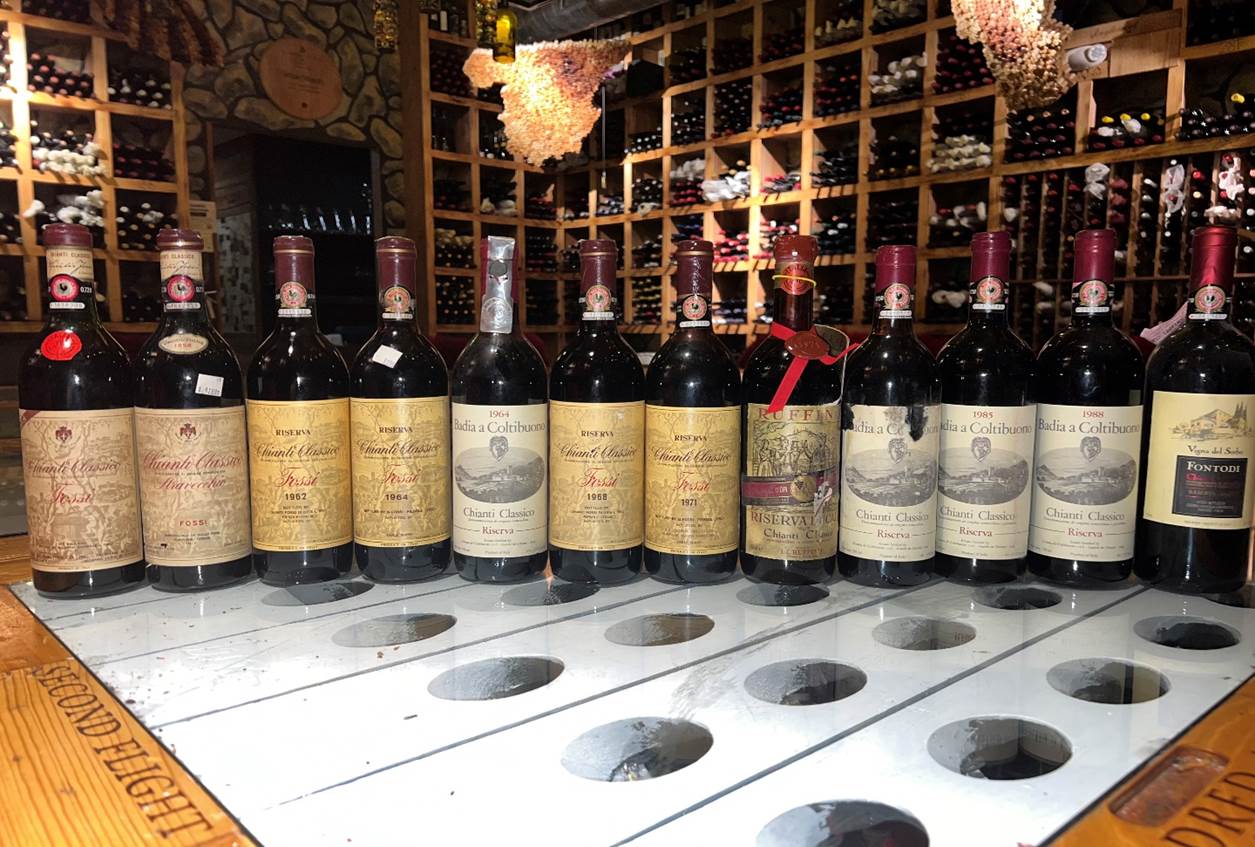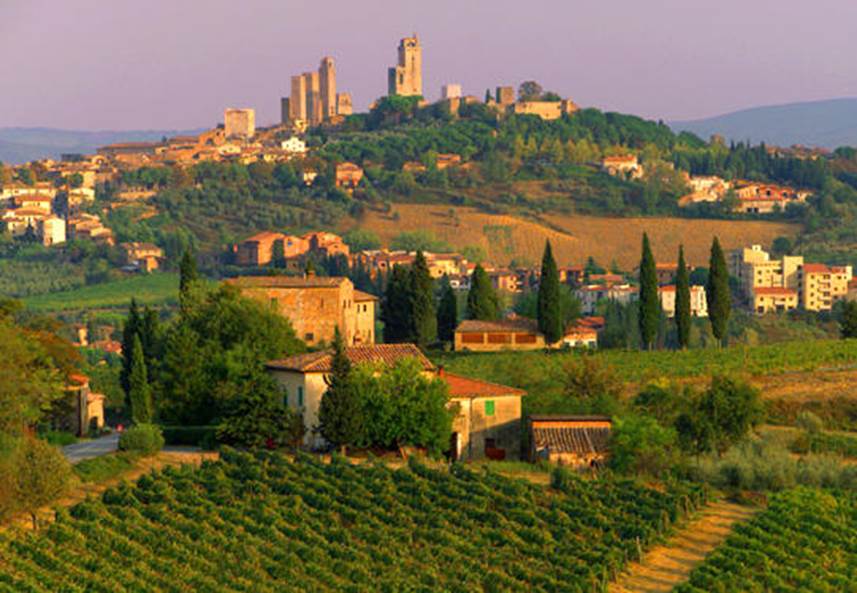Vintage Chianti Wine Tasting back to the 1958 vintage
Friday, October 13, 2023 - 02:42 PM
This Event has been read: 835 times.

A census taker once tried to test me. I ate his liver with some fava beans and a nice chianti.
Hannibal Lecter - Silence of the Lambs
Most wine lovers have tried Chianti, from the simple wines that resemble Pinot Noir in color to some of Italy's greatest wines, Chianti probably differs in style more than any other DOCG wine from Tuscany.
We just received an incredible collection of old Chianti Classico going back to the 1958 vintage, including legendary vintages like, 1962, 1964, 1966, 1968, 1971, 1978, 1985 and 1988 so I decided it’s time to do some serious scientific work with Chianti. We are going to put all of them on the table on Friday, October 13th.
My favorite examples of Chianti and Chianti Classico or Chianti Classico Riserva are Sangiovese 100% varietal wines like the wines of Fattoria Felsina and Fontodi. What is the difference with these different types of Chianti? Well there are several different zones in Chianti and the laws have changed a bit over the years but we can thank web sites like Wikipedia for making the laws and history a bit easier to understand, so I have included and excerpt from Wikipedia on Chianti for you at the end of this offering for those of you that want a lesson in Chianti. I have also included a piece from the Wine Advocate on the latest and greatest thing from Chianti the Gran Selezione. And if you are still not clear on what Chianti is we can’t help you.
I had never heard of the main producer in this tasting but Fossi must have been considered a great Tuscany producer in the 1960’a and 1970’s as the original price tag on the 1958 FOSSI CHIANTI CLASSICO STRAVECCHIO DOCG, TUSCANY, ITALY reads $41.99 which would have been released in the 1960’s and that would be around $400 dollars today. A hefty price for a bottle of Chianti in 1965!
This is a “Once in a Lifetime” Chianti Classico wine tasting with 12 vintages all over 23 years old and the oldest is 65 years old!! The fee for this tasting which includes dinner is $295 + tax, for reservations call 954-523-9463 or e-mail andy@winewatch.com. Please let us know when you make your reservations if you have any dietary restrictions and chefs Toni and Dani will be happy to accommodate you.

VINTAGE CHIANTI CLASSICO WINE TASTING BACK TO 1958
Friday, October 13, 2023
7:30 PM
1958 Fossi Chianti Classico DOCG, Tuscany, Italy
1958 Fossi Chianti Classico Stravecchio DOCG, Tuscany, Italy
1962 Fossi Chianti Classico Riserva DOCG, Tuscany, Italy
1964 Fossi Chianti Classico Riserva DOCG, Tuscany, Italy
1964 Badia a Coltibuono Chianti Classico Riserva DOCG Tuscany, Italy
1968 Fossi Chianti Classico Riserva DOCG, Tuscany, Italy
1971 Fossi Chianti Classico Riserva DOCG, Tuscany, Italy
1971 Rufino Riserva Ducale Chianti Riserva DOCG Tuscany, Italy
1978 Badia a Coltibuono Chianti Classico Riserva DOCG Tuscany, Italy
1982 Badia A Coltibuono Chianti Classico Riserva DOCG Tuscany, Italy
1985 Badia a Coltibuono Chianti Classico Riserva DOCG, Tuscany, Italy
1988 Badia a Coltibuono Chianti Classico Riserva DOCG, Tuscany, Italy
1997 Terreno Chianti Classico Riserva DOCG, Tuscany, Italy
1998 Fontodi Chianti Classico Riserva Sorbo DOCG, Tuscany, Italy
Menu
Selection of Cheese and Charcuterie
White Bean and Escarole Soup with Turkey Meatballs
Taglialini Pasta with Duck Foie Gras Sausage, Sundried Tomatoes, Pine Nuts and Goat Cheese
Chicken Marsala
Almond Biscotti with Grappa Whipped Cream
The fee for this tasting which includes dinner is $295 + tax, for reservations call 954-523-9463 or e-mail andy@winewatch.com. Please let us know when you make your reservations if you have any food allergies and chefs Toni and Dani will be happy to accommodate you.
Chianti
From Wikipedia, the free encyclopedia

Chianti (pronounced ['kjanti]) is a red Italian wine produced in Tuscany. It was historically associated with a squat bottle enclosed in a straw basket, called a fiasco ("flask"; pl. fiaschi); however, the fiasco is only used by a few makers of the wine now; most Chianti is now bottled in more standard shaped wine bottles. Baron Bettino Ricasoli (later Prime Minister in the Kingdom of Italy) created the Chianti recipe of 70% Sangiovese, 15% Canaiolo and 15% Malvasia bianca in the middle of the nineteenth century.[1]
The first definition of a wine-area called Chianti was made in 1716. It described the area near the villages of Gaiole, Castellina and Radda; the so-called Lega del Chianti and later Provincia del Chianti (Chianti province). In 1932 the Chianti area was completely re-drawn and divided in seven sub-areas: Classico, Colli Aretini, Colli Fiorentini, Colline Pisane, Colli Senesi, Montalbano and Rùfina. Most of the villages that in 1932 were suddenly included in the new Chianti Classico area added in Chianti to their name-such as Greve in Chianti which amended its name in 1972. Wines labeled Chianti Classico come from the biggest sub-area of Chianti, that sub-area that includes the old Chianti area. The other variants, with the exception of Rufina from the north-east side of Florence and Montalbano in the south of Pistoia, originate in the respective named provinces: Siena for the Colli Senesi, Florence for the Colli Fiorentini, Arezzo for the Colli Aretini and Pisa for the Colline Pisane. In 1996 part of the Colli Fiorentini sub-area was renamed Montespertoli.
During the 1970s producers started to reduce the quantity of white grapes in Chianti. In 1995 it became legal to produce a Chianti with 100% Sangiovese. For a wine to retain the name of Chianti, it must be produced with at least 80% Sangiovese grapes.[2] A Chianti may have a picture of a black rooster (known in Italian as a gallo nero) on the neck of the bottle, which indicates that the producer of the wine is a member of the Gallo Nero Consortium, an association of producers of the Classico sub-area sharing marketing costs.[3] Since 2005 the black rooster has been the emblem of the Chianti Classico producers association.[4] Aged Chianti (38 months instead of 4-7), may be labelled as Riserva. Chianti that meets more stringent requirements (lower yield, higher alcohol content and dry extract) may be labelled as Chianti Superiore, although Chianti from the "Classico" sub-area is not allowed in any event to be labelled as "Superiore".
Operation Chianti Classico and the Gran Selezione Challenge:
This is the latest thing from Tuscany and there is a very good explanation on the subject of Chianti Classico Gran Selezione taken from the Wine Advocate below:
Sergio Zinagrelli and his team at the Consorzio came up with a three-step plan aimed at solving some of these problems. First, he hired branding consultants to redesign the famous Black Rooster logo. They introduced a younger, more robust-looking bird with a feathered breast, an open beak and a fuller tail. "The Gallo Nero is more elegant, masculine and modern," says Zingarelli. The Consorzio also took steps to make the logo more visible on the bottle. In the past, the Gallo Nero symbol appeared on the pink appellation tape that is attached to the capsule. Today, producers are directed to place the Black Rooster logo either on the neck of the bottle or on the back label.
A second measure was taken to help improve quality from the bottom up. Bulk wine must be certified according to the quality standards set forth by the Consorzio before it is sold. That means bulk producers must adhere to the more stringent farming and vinification practices if they intend to sell in volume. This step is aimed specifically at making sure the bottom does not fall out of the bulk market, dragging down the image of the whole region with it.
The last and most controversial step taken in the Operation Chianti Classico revitalization scheme is the introduction of a new category of wine. In order to sharpen the apex of the so-called quality pyramid, a third category of Chianti Classico was created called Gran Selezione. Chianti Classico Gran Selezione exists above Chianti Classico Riserva and above Chianti Classico. The new wine will represent approximately 10 percent of the appellation's production. In order to qualify as Gran Selezione, grapes must be estate harvested from specific vineyard sites. Fruit must also be destined to Gran Selezione status. In other words, a producer can't simply call a wine Gran Selezione after blending and barrel aging. The wines age for at least 30 months (compared to 24 months for a Chianti Classico Riserva) and they must reflect a specific taste and flavor profile. Like Chianti Classico they are a minimum 80% Sangiovese, although many producers have moved towards 100% expression of the grape. They must have a minimum 13.03 alcohol % Vol, 4.65 total acidity g/l and 27.67 extract g/l. Maximums reach 15.52 alcohol % Vol, 6.50 total acidity g/l and 35.52 extract g/l. These are big wines.
Immediately following the introduction of Gran Selezione, questions and doubts were voiced. The leading questions are as follows:
1. In the already identity-challenged Chianti Classico appellation, does it make sense to
introduce another wine (with a slippery and nonspecific name such as "Gran Selezione")
that might further confuse consumers?
2. Why wasn't the emphasis on vineyard selections, following the successful model set forth
in Barolo and Barbaresco for example? In those regions, wines embrace a resoundingly
strong cru identity.
3. Will the Riserva category be squeezed out by the Gran Selezione category?
4. Lastly, do the uniform Gran Selezione stylistic requirements only serve to delineate a
holding receptacle for wines that would otherwise be called IGT Toscana? In other words,
did they simply create a new category of internationally-styled super Tuscans?
Answers to these questions remain open. Time will tell. It's hard to answer the first question and I had a long conversation with Sergio Zingarelli on the subject over lunch. Many alternative names were proposed and many eliminated because of copyright conflicts with other great wine regions of the world. Ultimately, it was impossible to find consensus among the approximately 600 member producers in the appellation and the 21 people who sit on the Consorzio board. Gran Selezione was the best they could come up with and there is hushed acknowledgment among producers that it was a compromise solution. There was much focus on trying to add a "vineyard" or "cru" element to the name (something like "Grande Vigneto") but that never panned out.
In terms of the second question, I'm happy to report that there is a very healthy discussion underway to render greater territorial identity. The Chianti Classico production zone falls under nine townships (in both the Siena and Florence provinces). The great majority of the wine is made in Castellina in Chianti, Radda in Chianti, Greve in Chianti, Gaiole in Chianti and Castelnuovo Berardenga. The wine is also made in smaller quantities in Barberino Val d'Elsa, San Casciano Val di Pesa, Tavarnelle Val di Pesa and Poggibonsi. Leading wine personalities have been pushing hard to allow for comune (or township) naming on the labels of the wines. "By concentrating on what makes these townships so special, the weather, soils, exposures and varying altitudes of each municipality, we avoid the trappings of putting so many brands together under the large Chianti Classico umbrella," says consulting winemaker Stefano Chioccioli. The idea is to allow producers to put the name of the township under the appellation on the label, as in "Chianti Classico, Castellina in Chianti." One big problem with this idea, however, is Panzano in Chianti. Although Panzano is one of the most celebrated sites in Chianti Classico (it is home to the Conca d'Oro amphitheater-shaped vineyard that is farmed by Fontodi and others), it is not its own township. Panzano falls under the Greve in Chianti municipality. An exception might be made to allow producers in Panzano to use that identity instead of Greve in Chianti.
With regards to the third question, it's likely that the Chianti Classico Riserva category will indeed face serious challenges now that it is no longer the region's top wine. Debate concerning Riservas has flared up in various Italian regions including Brunello di Montalcino, Barolo and Barbaresco. Again, many top brands are anxious to express their best wines in terms of vineyard selection or cru, not Riserva. A vineyard selection renders a concrete vision and is ultimately easier to convey to consumers and the trade. "Riserva" is loosely defined and more difficult to communicate because it can mean different things across the Italian territory. Riserva can denote extra barrel aging, or it could also be a special selection of fruit. It lacks a standard identity.
In order to address the forth question, I need to revert to my tasting notes. In June 2014, 95 wines were approved for the newly created Chianti Classico Gran Selezione status. I tasted most of those wines for my report. My general impression is that these debut wines are of excellent quality, despite some variation due primarily to the hot growing season in 2011. I very much enjoyed the Chianti Classico Gran Selezione wines made by Castello di Ama, Fèlsina, Renzo Marinai, San Felice and Tolaini among others. They showed great consistency and a uniform style that prizes thicker extract and soft tannins. The wines are bold, opulent and velvety with compelling accents of dark cherry and spice. Only a handful of wines pursued a streamlined and "traditional" style. Castello d'Albola's 2010 Chianti Classico Gran Selezione Il Solatio, for example, reflected the more feminine characteristics of the cooler vintage and higher-altitude vineyards. Besides these few exceptions, I found the Gran Selezione wines to reflect homogenous ideals and a consistent approach. If the intent of Gran Selezione is to challenge Italy's greatest wines (such as Brunello di Montalcino), I believe the quality of the wines is up to par. Like "Riserva," the challenge will be to communicate what "Gran Selezione" really stands for. Stylistically, they speak to sun-drenched Tuscany more than to any specific variety including Sangiovese.
The Tignanello Test
For me, the success of this new category falls on what I like to call the Tignanello Test. Should wines like Marchesi Antinori's Tignanello, Fontodi's Flaccianello della Pieve or Isole e Olena's Cepparello opt to become Chianti Classico Gran Selezione, the new category would have serious legs to stand on. We've already seen a few exciting converts including Fontodi's Chianti Classico Gran Selezione Vigna del Sorbo, Marchesi Antinori's Chianti Classico Gran Selezione Badia a Passignano and Mazzei's Chianti Classico Gran Selezione Castello Fonterutoli. If more iconic brands make the jump, Gran Selezione would get the confidence boost it seeks. I find it doubtful that Tignanello would ever shed its groundbreaking IGT status. Antinori enologist Renzo Cotarella explains: "Even though Tignanello respects the DOCG appellation rules, we feel that a Chianti Classico should not be conditioned by 20 percent Caberent Sauvignon." The Wine Advocate —Monica Larner
Cart Summary
Your shopping cart is empty!
Wine Watch Events
Vertical Tasting of Fontodi Flaccianello della Pieve
Sat, Jul 27, 2024
If reassurances could dull pain, nobody would ever go to the trouble of pressing grapes. SCOTT LYNCH, The L...
Wine Cave is Available for a Private Dining Experience
Sat, Jul 27, 2024
We have a minimum of 6 people to reserve the table in the Cave but we will take up to 16 p...
Happy Hour Wine Tasting Featuring Washington State Wines
Thu, Aug 1, 2024
Bring water, bring wine, boy! Bring flowering garlands to me! Yes, bring them, so that I may try a bout with...
Wine Cave is Available for a Private Dining Experience
Thu, Aug 1, 2024
We have a minimum of 6 people to reserve the table in the Cave but we will take up to 16 people for a ...
Wine Cave is Available for a Private Dining Experience
Fri, Aug 2, 2024
We have a minimum of 6 people to reserve the table in the Cave but we will take up to 16 people for a ...
Magnum Champagne Party Featuring Krug, Dom Perignon, Cristal and More...
Fri, Aug 2, 2024
An artist is somebody who produces things that people don't need to have. Andy Warhol ...
Wine Cave is Available for a Private Dining Experience
Sat, Aug 3, 2024
We have a minimum of 6 people to reserve the table in the Cave but we will take up to 16 people for a ...
Washington State's Finest Featuring Vintage wines from Quilceda Creek, Leonetti Cellars, Woodward Canyon, J. Bookwalter, Passing Time and more..
Sat, Aug 3, 2024
> "Old red wine, not worth a dime; we'll have to finish it after crossing the ...
Wine Bar is Closed
Thu, Aug 8, 2024
Wine Bar is Closed
Wine Bar is Closed
Fri, Aug 9, 2024
Wine Bar is Closed
